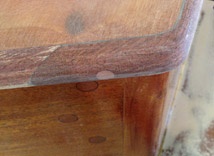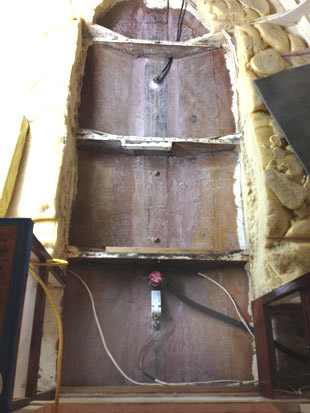Catboat Maintenance
February 28, 2006: Holes
Coming home from a solo night sail, across the wind, I rammed a corner of the dock and cracked open the plywood hull between frames above the waterline.
To repair the damage, I troweled thickened epoxy into the broken plywood then sandwiched it between two panels of 1/4" plywood, 18" square, covered in plastic wrap. A few dozen drywall screws, run from inside and out, took up the slack. The rest was filler, sandpaper, and paint.
Since then, I have holed the boat three more times. I adhered heavy fiberglass cloth to the inside of the hull, between frames 3&4, 4&5, P&S. The next time I crash into the dock, this fiberglass is supposed to distribute the force, as if pressing on a drum head.
October 2007: Trailer
Refitted a Magnum trailer with new bearings, wheels, tires, boat stand tops, and a timber down the center.
January 20, 2008: First Haulout
In October 2007, we tied up next to Mike Odom's double-decker house boat and took down the mast. Mike steadied the mast from above.
In January we called Eric Stough to bring Cupholder home on the new trailer.
It was three months of paint and varnish. Fixed the warp in the rudder. Applied a coat of hard bottom paint over the original, soft bottom paint. Officially named CUPHOLDER.
On April 16, 2008, Rob Gunderson hauled Cupholder to the lake. Must rope and sink the trailer for Cupholder to float free.
On May 4, 2008, Mike Odom helped us step the mast from his houseboat then helped with the rigging. Thanks Mike!
October 2010: Second Haulout
To handsomely remove Cupholder's mast which is 25' long, hire the crane at the marina. If the marina is closed, then take down the rigging and motor to the middle of the lake. Lift and heave the mast into the water. Try not to get hurt. Motor home towing mast.
Martin Clarke and I trailered Cupholder and brought her home. Did a proper bottom job, repaired a rotten place around the swim ladder receiver, and added rod holders.
I removed all the exterior varnish, then followed instructions in Brightwork: The Art of Finishing Wood to oil-seal mahogany before varnish. Bad idea. In two years, the varnish completely separated from the wood.
Marty relaunched Cupholder on April 30, 2011.
On June 16, 2011, we hoisted the mast using a halyard from two neighboring sloops, then drove Cupholder under the mast for stepping. Switched from a luff lash to mast hoops.
November 26, 2012: Third Haulout
The right tool for the job, a crane, lifted the mast from Cupholder today.
Two days later with kind permission of Bob Leonard, we trailered Cupholder at West Beach Marina. The ramp at my marina is closed due to low lake levels.
In the spring, I rigged Cupholder to carry her own spars, and she was off to sail the 2013 Texas 200.
2015: Year of Repairs
Cupholder is not a self bailer. Any rainwater she catches runs to the lowest part of the bilge where it must be pumped out. For 11 years, her bilge has always been wet.
She went into the shop in December 2014. When dry, I removed all floor boards for a close look in the bilge. My ice pick found soft places in the plywood hull and oak framing deep in the bilge. The soft places lacked epoxy resin. Everywhere else was OK.
The repair involved removing the punky wood, then a borate treatment, then laminations of wood and fiberglass cloth set in epoxy resin. The punky frame floor got a sister floor. The repair added years to her life.
I made new molding to go around the cabin top. The plan calls for a 3/4"
half-round to hide the edge
 of the plywood top. The half-round never looked right because it sat like a bump on the cabin sides.
The new molding fairs with the top of the house and provides a drip edge. New corner pieces wrap around
the curves of the corner posts.
of the plywood top. The half-round never looked right because it sat like a bump on the cabin sides.
The new molding fairs with the top of the house and provides a drip edge. New corner pieces wrap around
the curves of the corner posts.
The cockpit seats and floor boards are fir and Aquatek plywoods, plywoods that check and crack and ruin the paint. I stripped the paint and adhered/expoxied a layer of cotton duck canvas, making a non-skid surface that takes paint well.
Back in 2003, I used Interlux Brightsides polyurethane enamel for the top-side paint. For years, Brightsides has been flaky and brittle. It always cracked at the seams within days of recoating. I sanded it off. In places, I could remove it with masking tape.
I use old-school alkyd enamel now, a definite improvement. Benjamin Moore and Sherwin Williams sell an oil-based alkyd enamel known as direct-to-metal paint, or DTM. No problem using this paint on wood. Perhaps they call it metal paint because metal expands and contracts, like wood.
I prefer Benjamin Moore because Sherwin Williams is impossible to brush without adding Penetrol and naptha. Benjamin Moore brushes beautifully right from the can. These paints are available in low gloss, unlike Brightsides which is high gloss only.
The failed varnish of 2010 came off easily with a heat gun, but sanding was a nightmare as the oil clogged the sandpaper instantly. Still a problem today.
The gunnel rub rails rotted. They were red oak, a poor choice. The new rails are white oak.
July 2019: Relaunch
Back on the water after six years.
Feb 2020: Paint Over Varnish
The Texas sun has driven me to alkyd enamel. I chose a color that approximates dark mahogany.
Even though I sanded down to bare wood, there remains oil from 2010 that plays hell the new paint. Ugh.
Summer 2020: Honda 5 HP Rough Idle
The Honda BF5A developed a rough idle in 2012. The videos on YouTube told me to remove the idle jet, spray the blockage clean, and reinstall.
However, that did not work. For my engine, I had to clear the tiny path leading from the idle jet socket to the throat of the carburetor. This required a combination of carb cleaner and pressure.
